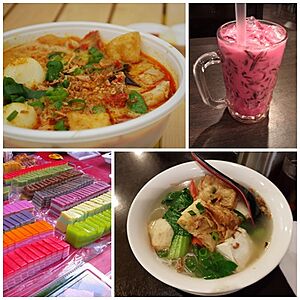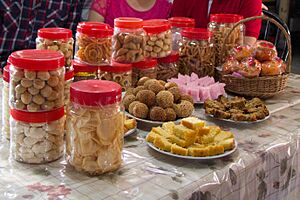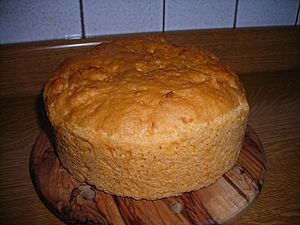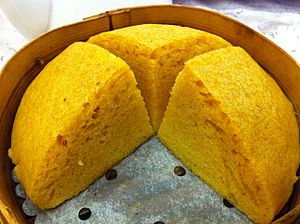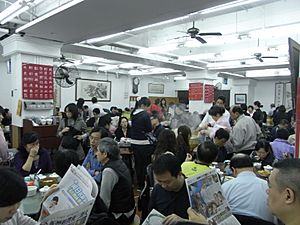Malay sponge cake facts for kids
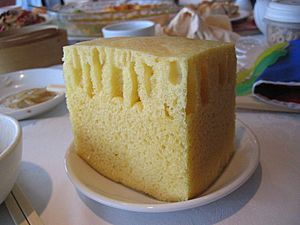
Malay sponge cake at a Cantonese restaurant
|
|
| Alternative names | Ma lai go, ma lai gao, Malay cake, and others |
|---|---|
| Course | Dim sum, xiaochi |
| Place of origin | China, Malaysia |
| Region or state | Guangdong (Guangzhou, Hong Kong) |
| Main ingredients | Traditionally made with levain, flour, white sugar and eggs |
Malay sponge cake is a yummy dessert cake. It's known as ma lai go in Cantonese and ma lai gao in Mandarin. This cake is super popular in Guangdong, China, and in Hong Kong. You can often find it at traditional teahouses there.
Malay sponge cake is made with ingredients like lard or butter, flour, and eggs. It gets its fluffy texture from being steamed in a bamboo steamer. A whole Malay sponge cake is a big, round, yellow cake. But it's usually sold in slices at teahouses. There are different ways to make it, but it should always be soft, sweet, and a bit chewy.
Contents
Where Did Malay Sponge Cake Come From?
People have a few ideas about where Malay sponge cake first started. Let's explore the main theories!
From China to Malaysia
One idea is that Malay sponge cake began in Guangdong, China. Then, it traveled to Malaysia. This happened during the second big wave of Chinese people moving to Malaya (now Malaysia). This was when the British ruled the area.
In the early 1930s, many Chinese people moved to Malaya. They were trying to escape poverty in China. Most of them came from Fujian and Guangdong provinces in China. These new arrivals brought their languages and cultures with them. This included Cantonese language and Cantonese cuisine. This helped create the diverse culture Malaysia has today.
Malaysian food is a mix of many cultures. You can find foods from all over the world there. Chinese food is especially varied. Malay sponge cake is popular in Malaysia, just like other Chinese foods such as Bah Kut Teh. So, it makes sense that the cake might have come from Guangdong, China, to Malaysia.
From Malaysia to China
Another idea is that Malay sponge cake came from a British dessert. Then, Chinese people brought it back to China. During the time the British ruled Malaysia, English colonists loved their afternoon tea with cake.
However, ingredients like milk and cooking tools like ovens were not common in Malaysia. So, local people used coconut milk and steamers instead. This created a different version of the English cake, which became the Malay sponge cake. Many people from Guangdong traveled between Malaysia and mainland China back then. It's possible they brought this new cake back home with them.
From Portugal to China
A third theory suggests the cake came from a type of sponge cake called Castile cake. Portuguese sailors brought this cake to the Nanyang region (Southeast Asia) in the 16th and 17th centuries. Then, early Chinese immigrants from Guangdong brought it back to China.
Sponge cakes were great for long sea trips because they lasted longer. They were a tasty treat when food was scarce. The Portuguese had a safe base in Malacca in the Nanyang region. Many ships from Europe and Asia stopped there. This allowed more Asian people to learn about sponge cakes and how to make them. Many early immigrants from Guangdong were bakers.
Traditional Chinese cooking didn't use Western baking methods. So, people often steamed these cakes in the traditional way, like steamed buns. Even though they used flour, eggs, and butter, the result was more like steamed bread. This new food was called "Malay cake" when it arrived in Guangdong during the late Qing dynasty. Later, people started using lard or butter instead of the original butter. This made it the classic Cantonese tea treat we know today: "Malay sponge cake."
Hong Kong's Special Cake
Malay sponge cake is super popular in Hong Kong. Some people even call it Hong Kong's "national cake"! It's as important there as Lamington is in Australia or Pavlova is in New Zealand. The famous Lin Heung Teahouse in Central, Hong Kong, serves a very traditional version of Malay sponge cake. They also have other classic Hong Kong cakes.
How Malay Sponge Cake is Made
There are different ways to make Malay sponge cake. This means it can have different tastes!
Traditional Ingredients
Traditionally, Malay sponge cake is made with levain, flour, white sugar, and eggs. Levain is a special starter dough. It's also called "Lao mian" in Chinese. It's usually made with water, beer, and flour.
Modern Twists
Some versions of Malay sponge cake use brown sugar instead of white sugar. Others use coconut milk instead of regular milk. More recently, some recipes even add honey for a different flavor!
How to Enjoy Malay Sponge Cake
Malay sponge cake is usually served as a dim sum item or a "xiaochi" (snack). The cakes are served hot in the bamboo baskets they were steamed in. They often sit on a bed of dried leaves or a paper mat.
In Guangdong, Malay sponge cake is often eaten during traditional Cantonese tea time. Today, you can even find frozen Malay sponge cakes sold around the world!
|


